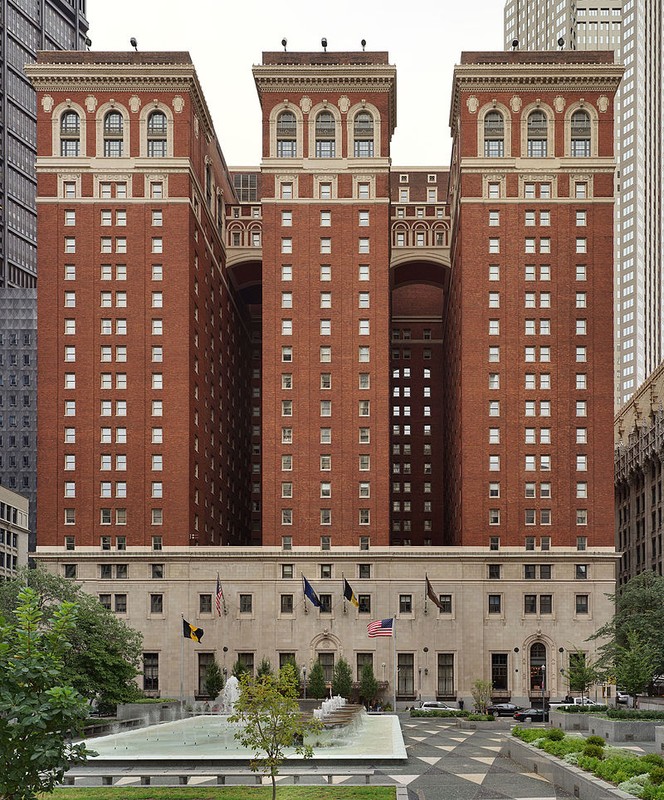Omni William Penn Hotel (William Penn Hotel)
Introduction
Text-to-speech Audio
Images
Omni William Penn Hotel (Frontal View)

Omni William Penn Hotel (Mellon Square View)

The Lobby of the Omni William Penn Hotel

Backstory and Context
Text-to-speech Audio
With a budget of $6 million, local architects, Benno Jannsen and Franklin Abbott were contracted to design The William Penn Hotel, and the George A. Fuller Company was hired to construct the building. After a year of construction, the William Penn Hotel was open for business. On the opening night of the hotel, the annual Pittsburgh Chamber of Commerce Gala was held in the main lobby. Covering approximately half a block of the western section in Mellon Sqaure, newspaper during the time were saying that the hotel was the "grandest hotel in the nation" due to its complex deign and size. Inspired by European architecture, the 23-story building has elements of Gothic Revival, Mediterranean, and Italian Renaissance. With the help of industrial architects, Henry Clay Frick and Joesph Urban, the building had 1600 rooms, a multi-layered lobby, a ballroom, several public rooms, and several dining halls by the late-1920s.
Originally, the hotel was originally owned by the Pittsburgh Hotel Company, but in 1928, the hotel was bought by the Eppley Hotel Company. The company then financed the expansion on another block of the eastern section in Mellon Square. However, the Epply Hotel Company lost control of the hotel during the Great Depression, and the Statler Hotel Company was brought in to help the Epply Hotel Company to manage the building from 1940-1951. Eventually, the hotel was later renamed the Penn-Sheraton Hotel after the Sheraton Hotel Company bought the hotel from the Epply hotel Company in 1956, and the deal between the companies went down in history as one of the largest hotel deals in the nation during the the time period. Later in 1968, Sheraton sold the hotel to a group of investors, and they greatly reduced the number of rooms to make new renovations for the building. Later, the Westin Hotel Company was brought in to help manage the building to which the building went under another name change, the Westin William Penn.
Among the various changes of ownership and name, the hotel was a favorable hot spot for movie stars, politicians, and socialites to stay, dine, or host events. For example, some of the hotel's presidential guest list included Herbert Hoover, Harry S. Truman, Dwight D. Eisenhower, John F. Kennedy, Richard Nixon, and Ronald Reagan. In addition, the hotel was also the site of comedian, Bob Hope's 1934 wedding proposal to American singer and actress, Dolores Reade.
In 2001, Omni Hotel and Resorts bought the hotel, and changed its name to its current status, the Omni William Penn Hotel. While the hotel boasted 1600 guest rooms in the 1920s, today the Omni William Penn Hotel has 597 guest rooms and 38 suites, a reflection of the expectations of modern travelers who demand larger rooms and private bathrooms. The hotel was listed on the National Register of Historic Places in 1984 with a nomination that emphasizes both architecture and its status as a Pittsburgh institution and one of the grandest hotels beyond New York City at the time of its completion.
Sources
George, Thomas. William Penn Hotel , National Park Services. November 3rd 1984. Accessed December 9th 2019. https://s3.amazonaws.com/NARAprodstorage/lz/electronic-records/rg-079/NPS_PA/85000458.pdf.
Omni William Penn Hotel, Pittsburgh, Historic Hotels in America. n.d. Accessed December 9th 2019. https://www.historichotels.org/hotels-resorts/omni-william-penn-hotel-pittsburgh/.
Omni Penn Hotel, Omni William Penn Hotel. n.d. Accessed December 9th 2019. https://www.omnihotels.com/hotels/pittsburgh-william-penn.
https://en.wikipedia.org/wiki/Omni_William_Penn_Hotel
https://en.wikipedia.org/wiki/Omni_William_Penn_Hotel
https://en.wikipedia.org/wiki/Omni_William_Penn_Hotel
